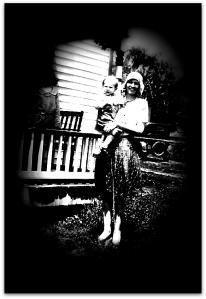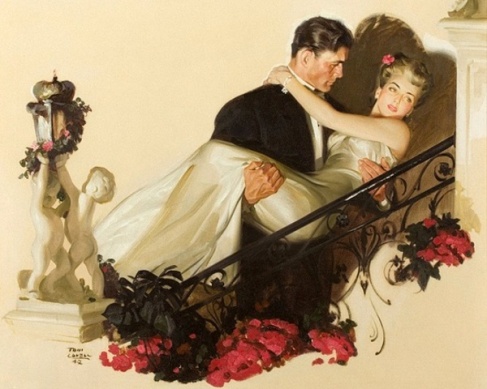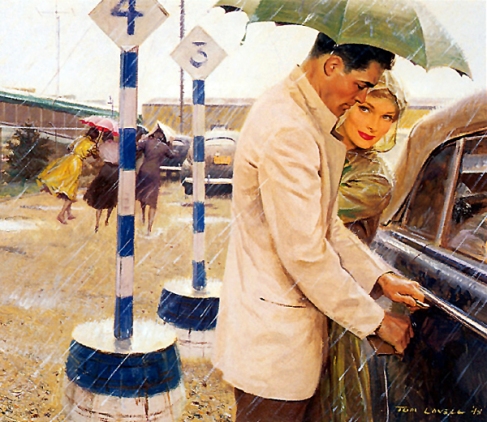Mine is not a family of photographers. We don’t click pictures of every party or parade. We don’t all put on white shirts and jeans to sit on rocks at the beach for annual family portraits. We don’t even usually remember to document landmark events like birthdays, graduations, or meals that aren’t burnt. That requires a certain kind of self-consciousness that we’re short on. It may have originated with my grandfather, who rejected the “bourgeois life of Wall Street” and moved his family into a utopian community in the 1930s.
Whole decades are missing from our family’s life in pictures. I never thought about it much, but now that I’m older I’m beginning to think not just about where our family is going, but where it’s been. We humans nearly always feel that inexplicable connection with the homelands of our ancestors, and with our “roots.” We know there is a genetic imperative to favor family, but it’s more than that. There’s a sense of grounding, of the permanence, even immortality that comes from seeing the long line of ancestors that reaches behind you, then panning forward we can see that same line extending into the future and on over the horizon.
My family is probably better at knowing we’re related to, say, Sir Isaac Newton or steamship builder Robert Fulton, than we are at knowing our immediate ancestors. Thankfully, my father’s long-gone mother documented his every childhood phase. Flipping though the photo album I see him posed in his christening gown, a page later in his velvet Little Lord Fauntleroy suit, then bundled in funny little coat and ready to go outside, then I flip the page and there he is with old Nell, the harness horse that pulled his grandfather’s buggy. In all these posed photos he was with his usually identically dressed fraternal twin brother.
But my mother? Fugedaboudit. I never saw a picture of her as a child. The earliest photo of her must be around age 22 or 23, and even then it’s just a snapshot from a distance far enough to have to look close to see it’s her. Of the few photos I have of her before age 45, none show a clear view of her face. This one, of her and my older brother as a baby, is typical:
 I don’t care how good your photo editing software is, you’re not going to find my mother’s face in there. Which is why my heart skipped a beat when I peered into a tiny two inch by three inch photo of my aunt and her toddler boy and there, in the shadowed background, was a figure that might have been my mother. Might have been. As in, I felt a glimmer of hope. Aunt Ola is front and center in the photo. She’s in the yard of her parents’ Shenandoah, Virginia house, all smiles and looking modern in her short skirt, flapper cloche and baby Ray in her arms. He’s wearing his jumper with the big buttons and white shirt, high socks, and his Buster Browns. There’s a Model something-or-other Ford in the driveway behind them. I’ve had the photo for years but never stopped to examine it because, well, it was Aunt Ola, not my mom, and that figure in the background was too faint to see much of. This is what the photo looked like to me. Like I have glaucoma:
I don’t care how good your photo editing software is, you’re not going to find my mother’s face in there. Which is why my heart skipped a beat when I peered into a tiny two inch by three inch photo of my aunt and her toddler boy and there, in the shadowed background, was a figure that might have been my mother. Might have been. As in, I felt a glimmer of hope. Aunt Ola is front and center in the photo. She’s in the yard of her parents’ Shenandoah, Virginia house, all smiles and looking modern in her short skirt, flapper cloche and baby Ray in her arms. He’s wearing his jumper with the big buttons and white shirt, high socks, and his Buster Browns. There’s a Model something-or-other Ford in the driveway behind them. I’ve had the photo for years but never stopped to examine it because, well, it was Aunt Ola, not my mom, and that figure in the background was too faint to see much of. This is what the photo looked like to me. Like I have glaucoma:
No, the borders aren’t really that dark, but this is exactly how the photo felt every time I glanced through the album. Then a few weeks ago I decided to restore some of our old photos and get copies to other family members. I brought out the album for the first time in quite a few years and looked at the pictures with the idea that the newest restoring and retouching programs could correct some of their problems. I took another look at the photo of Aunt Ola and baby Ray.
Could that be my mother? I had to move the lamp to spotlight the photo. I rested the heavy-handled and usually only decorative magnifying glass onto the edge of my keyboard, and practically stopped breathing to get an unblurred view. But yes, I was certain, that is my mother! I imagined she had just been out playing in the summer fields somewhere, maybe playing hide and seek with her Cardin cousins down at the corner. More likely she was with her mother in the garden. Unlike her sisters, she liked be out there digging holes with a hoe while her mother came along behind planting beans or peas. Or going along the bean rows with a stick in her right hand to knock worms off the leaves, dropping them into the pan she carried in her left hand.
Sometimes she climbed up into the big green gauge plum tree while her mother worked below. It was cool amid the leaves, and she liked to eat plums and watch her brothers out in the fields. Or sometimes she went in the kitchen and brought out the salt shaker, then poked around for the biggest, reddest, juiciest tomato, licking its silky skin so the salt would stick, then biting into its warm flesh till juice spilled down her chin and onto the front of her dress. No mind. Gardening is dirty work, and that’s what old clothes are for.
Whatever she was doing, it wasn’t being the star of any photograph. She may have looked up from whatever she was doing and seen Ola, her autocratic oldest sister, looking like the center of attention with her baby boy and having her photo taken by her husband, Raymond. Mom probably thought, oh no you don’t, it’s not just you and Ray and Raymond. I’m here too.” So she skipped up to the porch in her little black slippers, leaned over the rail, and smiled for the camera.
I sent the photo to an expert photo restoration artist and asked her to give it all she’s got. A day later she emailed me back this:
The thick brunette hair and something about that barely-visible face told me this might be the one and only photo that exists of my mother as a child, this half-lit figure peering over the porch railing, crowding into a photo that isn’t supposed to be of her. She looks about nine or ten. The camera is oblivious of her, but she’s smiling for the photographer like the beauty queen she would later be. I’d recognize that alabaster skin anywhere. Her mother made her carry a sun parasol whenever she was out in the sun. And her gorgeous hair. She wore it shoulder length into her early 50s, and it always fell across her forehead in cascades of soft waves. She told me about those slippers too. Her father bought them for her before a church recital, and she loved the dainty little things. So different from the lace-up boots with thick stockings that she wore all winter. I don’t know anything about that old dress, except that the last duty for any bit of clothing, before being torn up for rags and rag rugs, was for wearing to do work like cleaning and gardening.
This is the one picture to the thousands of words in the stories my mother has told me. The tomatoes and the plums and the bossy sister and the pretty slippers and the seed sack dresses and happy summers. It gives evidence to more than the stories too: To my experience of her smile and her soft hair and her impish humor. I am now the proud owner of exactly one photograph of my mother’s childhood. But that’s all I need, just the one.












